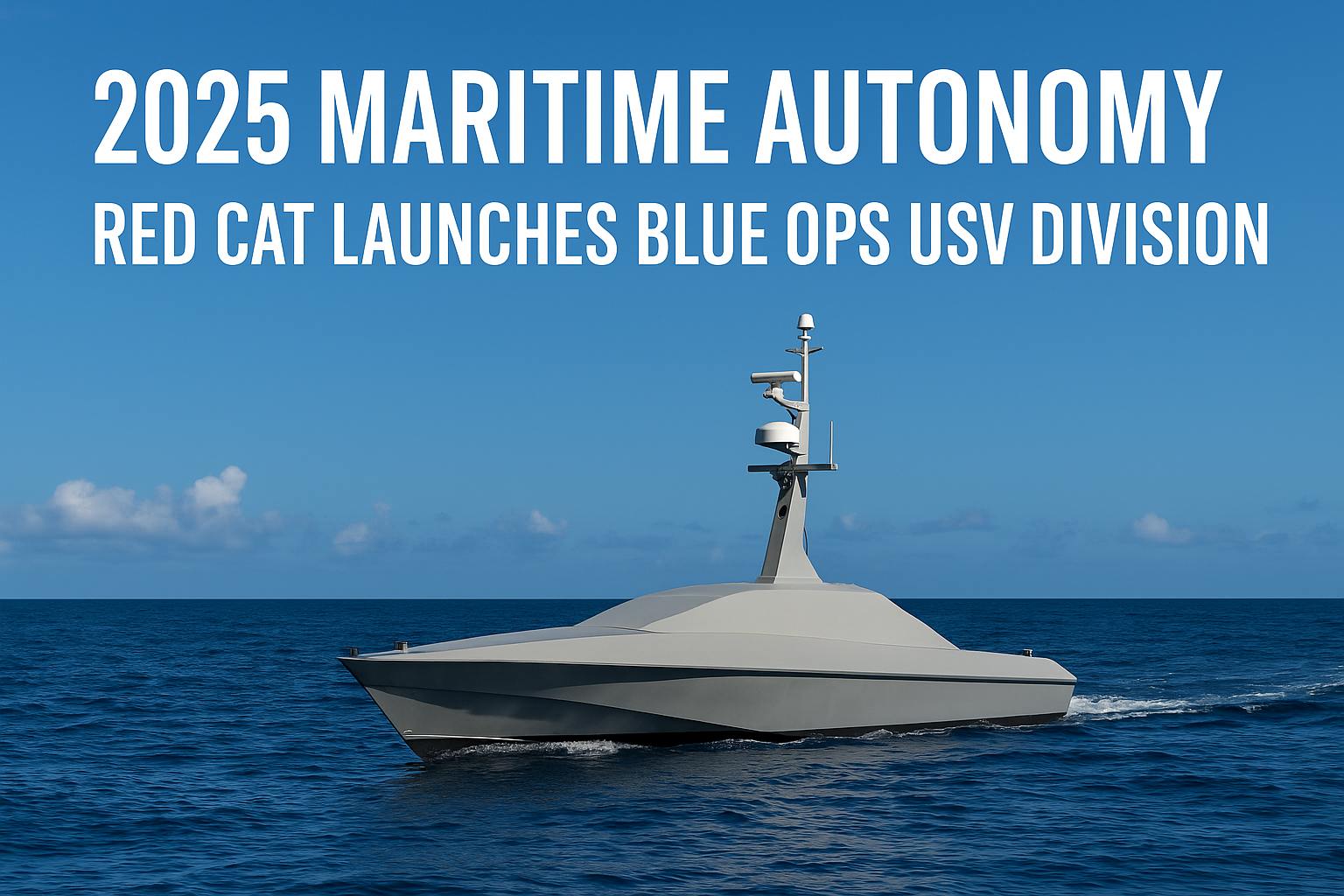U.S. drone manufacturer Red Cat Holdings Inc. announced the formation of Blue Ops, Inc., a new maritime division aimed at developing uncrewed surface vessels (USVs) and autonomous maritime platforms.
This expansion into the maritime domain highlights a strategic convergence between autonomy, defense innovation, and maritime cybersecurity. For an industry navigating new regulatory pressures and hybrid threats, the move symbolizes both progress and a wake-up call.
Why Blue Ops Matters for 2025 Maritime Autonomy USVs
Red Cat’s decision to enter the maritime autonomy sector reflects several accelerating trends shaping global shipping and defense:
- Force Multipliers: USVs extend naval and coast-guard presence without risking crews.
- Persistent Surveillance: Autonomous craft equipped with radar, LiDAR, and satellite links deliver continuous maritime domain awareness (MDA).
- Cost Reduction: Uncrewed platforms promise long-term efficiency—smaller crews, lower fuel use, and optimized routing.
- Operational Versatility: From reconnaissance and port-security patrols to environmental monitoring and logistics, modular USVs fit multiple missions.
This launch places Blue Ops among a growing field of innovators developing AI-driven maritime systems that can integrate into both commercial and defense fleets.
Key Technical and Regulatory Challenges
Technical Risks
- Communication Reliability: Autonomous missions depend on robust, redundant satellite and RF links.
- Collision Avoidance: AI navigation must dynamically account for congested waters and unpredictable weather.
- Energy Management: Hybrid and fuel-cell systems are needed for longer deployments.
- System Integration: Sensors, propulsion, and control software must operate seamlessly within existing maritime infrastructure.
Regulatory Barriers
- Certification Gaps: Flag states and classification societies are still developing autonomy standards.
- Liability Concerns: Responsibility for incidents remains legally undefined in most jurisdictions.
- Export Controls: Dual-use technology overlaps with military systems, triggering compliance obligations under ITAR/EAR.
Cybersecurity Risks
As with any connected platform, USVs expand the cyber attack surface:
- Spoofing and Hijacking: GPS and signal spoofing can redirect or disable vessels.
- Firmware Manipulation: Compromised updates could grant remote access to critical systems.
- Third-Party Supply Chain Exposure: Sensors and AI modules sourced internationally can introduce hidden vulnerabilities.
A single exploit could compromise navigation, data integrity, or fleet command—making cybersecurity a mission-critical design pillar.
Security and Operational Implications
For shipping lines, port operators, and defense contractors, the emergence of USVs changes the risk landscape:
- Pilot Programs First: Adopt semi-autonomous operations in controlled environments before scaling.
- Integrate Cyber from Design: Zero Trust architectures, strong encryption, and behavioral monitoring must be standard.
- Train for Human-in-the-Loop: Even autonomous fleets require remote operators, analysts, and incident-response teams.
- Collaborate with Regulators: Work with IMO, USCG, and classification societies to shape policy.
- Conduct Pen Testing on Maritime AI: Audit software supply chains and autonomous decision engines regularly.
The Future of Maritime Autonomy and National Security
Maritime autonomy is now as much about information dominance as mobility. Nations investing in USVs are positioning for a future where digital and physical maritime domains are inseparable.
- Dual-Use Potential: USVs can serve commercial and military purposes simultaneously.
- Intelligence Gathering: Continuous sensor feeds improve surveillance and response.
- AI Decision Loops: Machine learning enhances threat detection and navigation efficiency but requires transparent governance.
The rise of autonomous surface vessels marks a turning point—one that demands both innovation and ethical responsibility.
Conclusion
Red Cat’s creation of Blue Ops in August 2025 underscores how quickly autonomy is shaping the future of maritime operations. For an industry where OT systems, AI, and cybersecurity intersect, this moment is a call to action: prepare, secure, and adapt before autonomy becomes a baseline requirement.
Ready to assess your autonomous readiness?
Talk to The Saturn Partners about designing cyber and operational resilience for the next generation of maritime technology.

